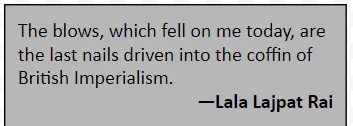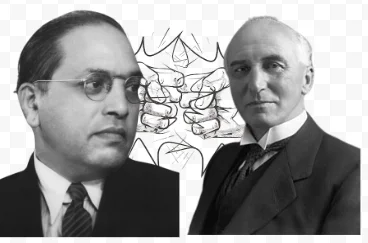Gandhi’s constructive workers immersed themselves in village life, Swarajists kept the government accountable in legislatures, Koya tribals in Andhra valiantly resisted the colonial state, Akalis in Punjab made significant contributions, and Satyagrahis defended the national flag in Nagpur in 1923. These efforts, along with countless others engaged in organizational, ideological, and agitational activities, maintained the spirit of nationalism at various levels. From the latter part of 1927, a noticeable surge in mass anti-imperialist sentiment began to emerge. Similar to the impact of the Rowlatt Bills in 1919, the British Government once again became a catalyst for this upsurge. On November 8, 1927, the announcement of an all-White commission to assess India’s readiness for further constitutional progress and the proposed lines of development provided a focal point for collective rallying against colonial rule.
Appointment of the Indian Statutory Commission
Members of the Simon Commission
|
The Government of India Act, of 1919, included a provision stipulating the appointment of a commission ten years after its enactment to assess the progress of the governance scheme and propose new measures. Subsequently, the British government under Prime Minister Stanley Baldwin, established the Indian Statutory Commission on November 8, 1927, it was sent to India in 1928 (February – March and October 1928 – April 1929) to study potential constitutional reform. In 1930, the Commission published its two-volume report, also known as the Simon Report. This seven-member, all-white commission, is commonly referred to as the Simon Commission (named after its chairman, Sir John Simon).
Enroll now for UPSC Online Course
Why constituted before the declared time?
While constitutional reforms were scheduled for 1929, the Conservative government in Britain, fearing potential defeat by the Labour Party, opted to address the future of their prized colony before the scheduled time frame.
- Instability of the Imperial Power: By the mid-1920s, the perceived instability of the imperial power, as evidenced by the shortcomings of the 1919 Act, had prompted various parliamentary reports and inquiries.
- Several Commission Recommendations: The Lee Commission examined the Raj’s struggles to recruit sufficient British officers, the Mudiman Commission investigated the deadlock within the diarchic dispensation, and the Linlithgow Commission delved into the crisis in Indian agriculture.
Given these circumstances, the British government deemed it necessary to conduct a more comprehensive assessment of the workings of the 1919 Act. Lord Birkenhead, the Conservative Secretary of State for India, who consistently expressed skepticism about Indians’ ability to formulate a concrete scheme of constitutional reforms with broad political support, played a key role in the appointment of the Simon Commission.
Indian Response
The immediate and almost unanimous Indian response to the Simon Commission was marked by anger. The main reason behind the agitation against the Simon Commission was that there were no Indian members of the panel and only seven British members of the British Parliament. This was viewed as racist and colonialist. The fundamental notion behind this exclusion—that foreigners would discuss and determine India’s readiness for self-government—was perceived as a violation of the principle of self-determination and a deliberate insult to the self-respect of Indians.
Congress Response
- Indian National Congress: It was the Indian National Congress that transformed the boycott into a widespread movement.
- The Congress had formalized the decision to boycott during its annual session in Madras in December 1927 under the presidency of M.A. Ansari resolved to boycott the commission at every stage and in every form.
- Declaration of Complete Independence: In the heightened and fervent atmosphere, Jawaharlal Nehru successfully passed a sudden resolution, declaring complete independence as the Congress’s objective.
- Gandhiji emphasized that protest should extend beyond mere resolutions, as articulated in the January 12, 1928, issue of Young India: “It is said that the Independence Resolution is a fitting answer.
- The act of appointment (of the Simon Commission) needs an answer, not speeches, however heroic they may be, not declarations, however brave they may be, but corresponding action…”
Other Groups
- Coalition of Political Groups: Various groups aligned with the Congress’s call for a boycott, including the liberals of the Hindu Mahasabha and the majority faction of the Muslim League led by Jinnah.
- The Muslim League, in its sessions in 1927, decided to oppose the Simon Commission under Jinnah at Calcutta, while Muhammad Shafi, supporting the government, led another session in Lahore.
- The call for boycotting the Commission further garnered support from the Liberal Federation under Tej Bahadur Sapru’s leadership, the Indian Industrial and Commercial Congress, and even the Hindu Mahasabha.
- However, some factions, like the Unionists in Punjab and the Justice Party in the south, chose not to boycott the commission.
Public Response
Upon the commission’s arrival in Bombay on February 3, 1928, a nationwide hartal (strike) was organized, accompanied by mass rallies. Black flag demonstrations, hartals, and chants of ‘Simon Go Back’ (A slogan given by Yusuf Meherally) greeted the commission wherever it went.
Public Unrest: In Madras, a significant clash with the police ensued, resulting in the firing and the unfortunate death of an individual. T. Prakasam exemplified the defiant spirit by baring his chest before armed policemen who unsuccessfully attempted to prevent him from reaching the scene of the incident.
Widespread Protests: Simon encountered black flags and demonstrations in every city he visited—Calcutta, Lahore, Lucknow, Vijayawada, and Poona. In Poona, the youth ingeniously drove alongside the train carrying black flags, from Lonavala to Poona.
In Lucknow, Khaliquzzaman floated kites and balloons with the slogan “Simon Go Back” during the reception organized by taluqdars.
Dr BR Ambedkar and the Simon Commission
|
Rise of Youth Activism
Youth Mobilization: The Simon Commission’s boycott movement marked the initiation of a young generation into political activism, with the youth playing a pivotal and dynamic role, infusing the movement with a militant spirit.
- While a youth movement had already commenced by 1927, active participation in the Simon agitation provided a significant boost to the formation of youth leagues and associations across the nation.
- Youth leagues and conferences experienced a surge in activity, with Nehru and Subhash Bose emerging as leaders of this new wave. Both leaders extensively travelled, addressed, and presided over conferences.
- Spread of Radical Socialist Ideas: This surge among the youth also served as fertile ground for the proliferation of radical socialist ideas, influenced by Nehru’s exposure to European socialism and his impressions of the Soviet Union.
- Other groups and individuals, such as the Naujawan Bharat Sabha in Lahore and the Workers’ and Peasants’ Parties, contributed to popularizing the socialist vision, creating links between anti-imperialist and socialist sentiments among the youth.

Police Repression
- Rising Police Brutality Against Protesters: While humor and creativity were evident, so was the pervasive anger at how the police handled the protesters.
- Lathi charges became increasingly common, sparing not even respected and senior leaders from blows.
- Violence and Tragedy: In Lucknow, Jawaharlal Nehru and Govind Ballabh Pant fell victim to police beatings. Tragically, in October 1928, Lala Lajpat Rai sustained severe blows to his chest during the protests, leading to his untimely demise on November 17, 1928.
- Lala Lajpat Rai’s death became the focal point for Bhagat Singh and his comrades, leading them to seek vengeance by killing the white police official, Saunders, in December 1928.
Impact of Appointment of Simon Commission on the National Movement
The appointment of the Simon Commission had a dual impact on Indian politics:
- Boost to Radical Forces: It provided a boost to radical forces advocating not only complete independence but also significant socio-economic reforms along socialist lines.
- The announcement of the Simon Commission presented the Congress, lacking an active agenda, with an issue that could catalyze mass mobilization.
- Acceptance of Lord Birkenhead’s challenge: Lord Birkenhead’s challenge to formulate a mutually agreed constitution, was embraced by diverse political factions and resulted in the Nehru Report, fostering optimism about the prospects of Indian unity during that period.
The Simon Commission Recommendations
In May 1930, the Simon Commission released a comprehensive two-volume report outlining its proposals.
- Abolition of Dyarchy: The recommendations included the abolition of dyarchy, the establishment of representative government in the provinces with increased legislative council members, and granting autonomy to the provinces.
- Discretionary Powers: The report advocated discretionary powers for the governor in matters of internal security and administrative authority to safeguard different communities.
- Governor General Power: However, it rejected parliamentary responsibility at the center, endorsing complete power for the governor-general to appoint cabinet members.
- The Government of India was to maintain full control over the high court.
- Separate Communal Electorates: The report recommended the retention of separate communal electorates (with possible extensions to other communities) until tensions between Hindus and Muslims subsided, eliminating the prospect of a universal franchise.
- Federalism: While the idea of federalism was acknowledged, its implementation was deferred to the future.
- Establishment of a Consultative Council: The report proposed the establishment of a Consultative Council of Greater India, incorporating representatives from both British provinces and princely states.
- Introduction of Local Legislatures: It suggested the introduction of local legislatures for the North-West Frontier Province and Baluchistan, with both regions having representation at the center.
- Separation of Provinces: Furthermore, the report recommended the separation of Sindh from Bombay and the detachment of Burma from India, citing geographical considerations.
Enroll now for UPSC Online Course
- Indianization of the Army: It proposed the Indianization of the army while retaining British forces, ensuring that India was adequately equipped.
| Must Read | |
| Current Affairs | Editorial Analysis |
| Upsc Notes | Upsc Blogs |
| NCERT Notes | Free Main Answer Writing |
Conclusion
The Simon Commission highlighted both the colonial government’s persistent disregard for Indian representation and the burgeoning nationalist fervor within India. The all-white panel’s exclusion of Indian voices ignited widespread protests, unifying various political groups and spurring radical youth activism. This period not only catalyzed the demand for complete independence but also laid the groundwork for significant political reforms, ultimately challenging the British government’s colonial authority and accelerating India’s path toward self-rule.
Sign up for the PWOnlyIAS Online Course by Physics Wallah and start your journey to IAS success today!
| Related Articles | |
| Swarajists vs. No-Changers | Government of India Act 1919 |
| Indian National Congress | CONSTITUTIONAL BODIES |

 GS Foundation
GS Foundation Optional Course
Optional Course Combo Courses
Combo Courses Degree Program
Degree Program



 mmission, Dr. Ambedkar appeared before the commission in October 1928. Advocating for ‘universal adult franchise’ encompassing both men and women, he proposed provincial autonomy in the provinces and Dyarchy at the Centre. Notably, the concept of universal adult franchise was not yet guaranteed in many European countries at that time.
mmission, Dr. Ambedkar appeared before the commission in October 1928. Advocating for ‘universal adult franchise’ encompassing both men and women, he proposed provincial autonomy in the provinces and Dyarchy at the Centre. Notably, the concept of universal adult franchise was not yet guaranteed in many European countries at that time.





